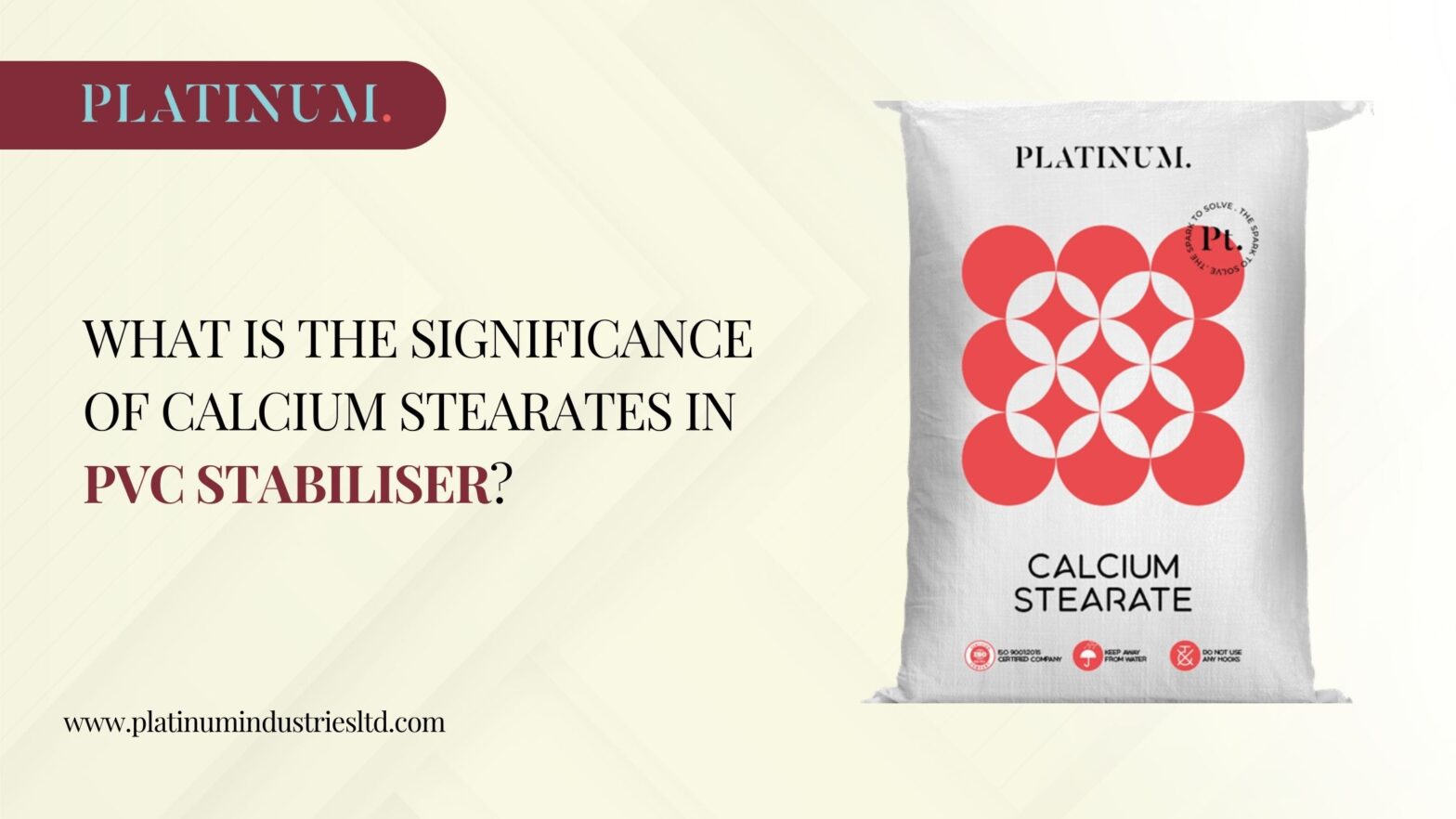In the area of industrial metal soaps and lubricants, there are multiple options for manufacturers to choose from. However, given the extensive experience of Platinum Industries within the area of these, what stands out as a lighthouse of performance and versatility among lubricants is Calcium stearate.
Let’s dive into the magic of Calcium stearate in Polyvinyl chloride applications:
1. Understanding Calcium Stearate:
What is meant by Calcium stearate? – As a chemist, Calcium stearate refers to the Calcium salt derived from pure stearic acid, which consists of 18 carbon atoms. This holds true even for individuals lacking a chemical background. However, this description is not entirely accurate. Why? – The discrepancy lies in the definition of stearic acid. Technically, ‘stearic acid’ is sourced from renewable raw materials, such as fats and oils, notably palm oil and tallow oil, from which ‘stearic acid’ is derived. Depending on their source, these raw materials exhibit varying compositions of different fatty acids. Among them, stearic acid with 18 carbon atoms (C18) is predominant, alongside palmitic acid (C16) and, to a lesser extent, myristic acid (C14). For users, the chemically precise term would be the Calcium salt of the C16-18 fatty acids. They even have different CAS numbers.
Pure Calcium stearate or Stearic acid Calcium salt:
CAS Number: 1592-23-0
Molecular weight: 607.0 g/mol
Formula: C36H70O4Ca
Technical Calcium stearate or C16-18 Fatty acid Calcium salt:
CAS Number: 15284-51-2
Molecular weight: not defined
Formula: not defined
3. Production and Properties:
Calcium stearate can be produced by several methods
– by a precipitation process in water
– by fusion process by reacting Calcium hydroxide with stearic acid at ambient temperatures
– Opposite to Calcium stearate it cannot be produced by a melt process by reacting Calcium hydroxide with melted stearic acid at 120 to 130°C
Depending on the amount and quality of stearic acid and Calcium components, a range of physical-chemical properties can be reached.
3. Heat Stability and Thermal Resistance:
One of the key advantages of Calcium stearates is their remarkable heat stability and thermal resistance. Even at high temperatures, Calcium stearates maintain their colour without decomposing or degrading, ensuring consistent performance in demanding industrial environments.
4. Application:
Calcium stearate demonstrates outstanding compatibility with a broad spectrum of polymers, encompassing PVC, polyethylene, polypropylene, rubber etc. etc.
| Grade | Application | %CaO | %FFA | MP/°C | Loss on dry (105⁰C/ 60 min) | Bulk density (tapped, g/l) |
| Calcium stearate -100 | PVC pipe, Economical grades of wire and cable compounding, construction chemical etc | 9.0 – 10.0 | < 1.0 | 155-160 | < 2.0 | 250 – 350 |
| Calcium stearate-SIL | In Polyolefin as acid scavenger, Wire and Cable, PVC pipe, Cosmetics, Construction chemicals, Ca-Zn Stabilizers etc | < 0.1 | 150-160 | < 2.0 | 250 – 350 | |
| Calcium stearate -200 | PVC pipe, Economical grades of wire and cable compounding, construction chemicals etc | 7.5 – 9.0 | < 1.0 | 150-165 | < 2.0 | 250 – 325 |
| Calcium stearate -300 | In Wire and cable and PVC pipe as acid scavenger and lubricant, Cosmetics, Construction chemicals etc | 6.0 – 7.0 | < 1.0 | 150-165 | < 3.0 | 300 – 350 |
| Calcium stearate -PETRO | In Polyolefin as acid scavenger, in Ca-Zn Stabilisers as heat stabiliser, as internal lubricant in PVC and other polymers processing ,as a water repellant in paints and other coatings etc | 9.2 – 9.6 | < 0.5 | 145-155 | < 3.0 | 150 – 250 |
| Calcium stearate- PIL | In Wire and Cable, PVC pipe, Construction chemicals, Ca-Zn Stabilisers etc. | < 2 | 145 -160 | < 3.0 | 150 – 350 | |
| Calcium stearate-PM | In Polyolefin as acid scavenger, Wire and Cable, PVC pipe, Cosmetics, Construction chemicals, Ca-Zn Stabilizers etc. | 9.6 – 10. | < 0.5 | 145-155 | < 3.0 | 200 – 300 |
5. Calcium Stearate in PVC:
Calcium stearate serves various functions in PVC applications. Primarily, it acts as a film former, forming a monomolecular film on hot metal surfaces. It promotes the fusion of the stabilised dryblend without touching extrusion torque and acts twice as a stabiliser:
– it takes over the Chloride ions from Zinc chloride which promotes the decomposition of PVC
– it acts directly as a acid scavenger by neutralising the HCl (Hydrochloric acid) which is formed while processing of PVC
Predominantly utilised in Calcium-Zinc and Calcium-organic stabilisers, Calcium stearate can also be combined with Tin and Lead stabilisers. However, every silver lining has a cloud. An overdose of Calcium stearate in PVC and esp. in rigid applications might result in plate out in the hot areas of an extrusion line.
6. Keywords:
#PVC #stabiliser #stabiliser #metal soaps #metallic soaps
As indispensable additives in PVC formulations, calcium stearates contribute to the stability, processability, and performance of PVC products.
To know more about purchasing high-grade calcium stearates, we can assist you. Being a member of the Indian Vinyl Council, Platinum Industries Ltd. is among the leading manufacturers of stearates that exceed industry standards
Platinum Industries Ltd., a member of Indian Vinyl Council (IVC)

